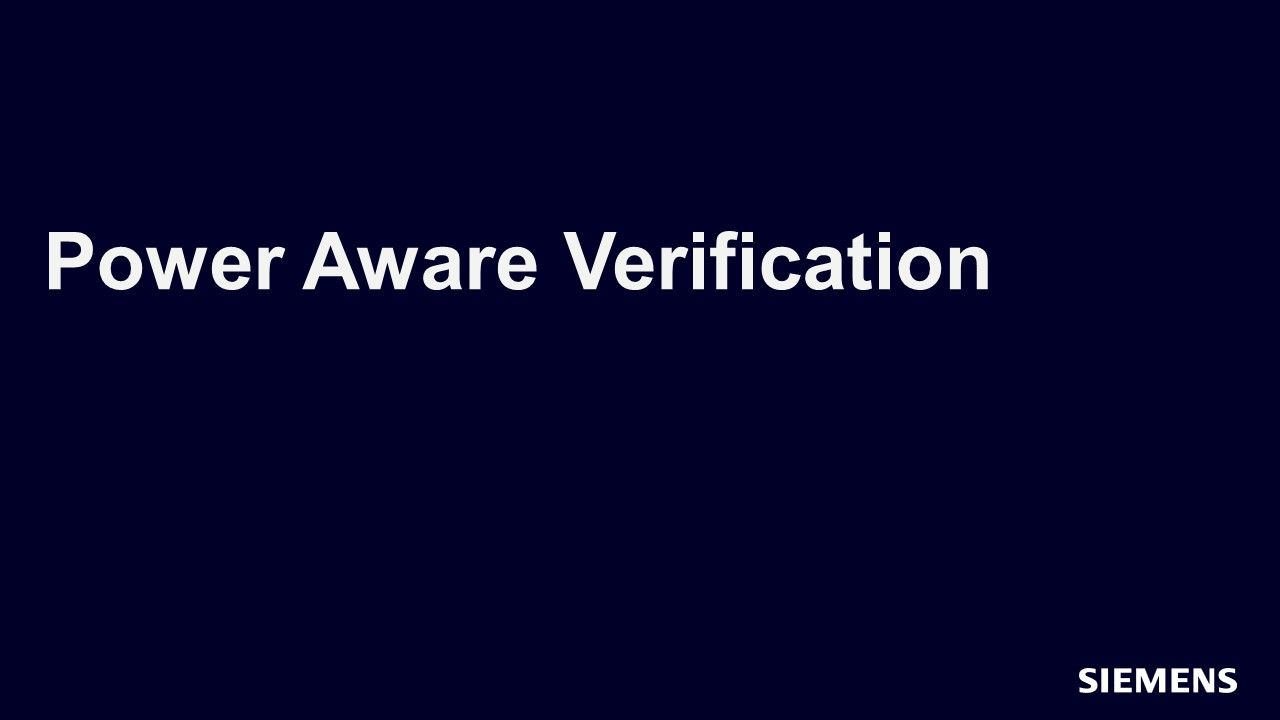Low Power
Low Power verification enables early (RTL) verification of active power management applied to a complex design, to ensure that the power management architecture and behavior are correct and that the design will operate correctly under active power management. Power Aware techniques simplify the verification process through a comprehensive suite of static checkers for checking the consistency of the power management architecture and dynamic checks for automated error detection.
Utilizing Low Power standards provide visualization of power management architecture and behavior, coverage data collection, and test plan generation for power states and state transitions. Based on the UPF for specification of active power management, Power Aware integrates well with other UPF-based tools to support multi-tool and multi-vendor low power design and verification flows.
-
Low Power Verification Tracks
-

Power Aware Verification
This track introduces the IEEE Std 1801 Unified Power Format (UPF) for specification of active power management architectures and covers the use of UPF in simulation-based power aware verification. -

Power Aware CDC Verification
In this track, you will learn the low power CDC methodology by discussing the low power CDC challenges, describing the UPF-related power logic structures relevant to CDC analysis, and explaining a low power CDC verification methodology. -

Sequential Logic Equivalence Checking
In this track, you will be introduced to the concept of sequential logic equivalence checking and its common applications. You will also learn how to start with Questa® SLEC to verify design optimization, bug fix/ECOs, low power clock gating logic, and safety mechanisms.
-
-
Low Power Discussion Forum
-
Block Container: Body Content
-
Low Power Introduction
In the ever-evolving landscape of VLSI (Very Large Scale Integration) design, the pursuit of lower power consumption has become a critical imperative. As electronic devices continue to permeate every facet of our lives, from IoT devices to mobile phones and data centers, the demand for energy-efficient systems has never been greater. This surge in demand places a significant responsibility on verification engineers, who play a pivotal role in ensuring that low power and power-aware techniques are seamlessly integrated into the design and function of VLSI circuits.
Understanding Power Consumption in VLSI Design:
Power consumption in VLSI circuits can be broadly categorized into two main types: dynamic power and static power. Dynamic power results from the charging and discharging of capacitors as the transistors switch states, while static power arises due to leakage currents in the off-state transistors. Verification engineers need to have a comprehensive understanding of these power components to effectively validate the low-power aspects of a design.
Challenges in Low Power Verification:
Low power verification poses unique challenges for verification engineers. Traditional verification methodologies may not be sufficient to ensure the correct functionality of a design under varying power conditions. Asynchronous and sporadic power changes, which are common in modern designs to conserve power, require verification engineers to adopt new strategies and tools to validate power-aware functionalities.
Power Domains and Isolation Techniques:
Modern VLSI designs often incorporate multiple power domains to selectively power down or scale the voltage of specific blocks. Verification engineers must verify the correct operation of power switches, isolation cells, and level shifters that facilitate communication between different power domains. Ensuring the robustness of these power management techniques is crucial to prevent unintended consequences such as data corruption or loss during power transitions.
Dynamic Voltage and Frequency Scaling (DVFS):
Dynamic Voltage and Frequency Scaling is a key technique employed in low power design to dynamically adjust the operating voltage and clock frequency of a processor or subsystem based on the workload. Verification engineers must validate the correct implementation of DVFS algorithms, ensuring seamless transitions between different power-performance states without compromising system stability or functionality.
Clock Gating and Power Gating:
Clock gating and power gating are widely used techniques to reduce dynamic power consumption by selectively disabling clocks or powering down specific portions of the design during idle or low activity periods. Verification engineers must rigorously test the functionality of these gating mechanisms to guarantee that the design behaves as expected under various operational scenarios. This includes verifying proper setup and hold times, avoiding clock domain crossing issues, and ensuring reliable power-up and power-down sequences.
Low Power Simulation and Emulation:
Traditional simulation methodologies may fall short when it comes to accurately capturing the intricacies of low power designs. Verification engineers often leverage advanced simulation and emulation tools that can model power transitions, leakage currents, and other low power effects with high fidelity. These tools enable engineers to perform exhaustive testing under realistic scenarios, helping uncover potential issues related to power management.
Unified Power Format (UPF) and Design for Low Power (DLP):
The adoption of standardized formats, such as UPF, has streamlined the process of specifying low power intent in VLSI designs. UPF allows verification engineers to define power states, power domains, and other low-power attributes in a consistent and machine-readable format. Verification engineers play a crucial role in ensuring that the UPF is correctly implemented and that the design adheres to the specified low power intent. Additionally, the concept of Design for Low Power (DLP) emphasizes incorporating low power considerations at every stage of the design process, from architecture to implementation, placing verification engineers at the forefront of this holistic approach.
Static and Formal Verification Techniques:
Static and formal verification techniques offer valuable tools for verification engineers in the low power domain. Static analysis tools can identify potential power-related issues by analyzing the design at the RTL (Register Transfer Level) or gate level without the need for simulation. Formal verification, on the other hand, employs mathematical techniques to exhaustively prove the correctness of low power aspects, helping catch subtle design flaws that may go unnoticed in simulation-based approaches.
Advanced Power-aware Debugging:
Effective debugging is a cornerstone of successful verification. In the realm of low power design, verification engineers face the challenge of debugging issues related to power management, such as incorrect power state transitions or unexpected power consumption spikes. Advanced debugging tools that provide visibility into power-related events, enable engineers to trace the root cause of issues efficiently. Techniques like power-aware waveform analysis and dynamic power profiling contribute to a deeper understanding of the design's power behavior during
-
Low Power Conclusion
The culmination of the relentless pursuit of energy-efficient VLSI (Very Large Scale Integration) designs is a testament to the pivotal role played by verification engineers. These engineers find themselves at the forefront of the intricate dance between functionality and power optimization, ensuring that low power and power-aware techniques are not just integrated but thoroughly validated. In the dynamic realm of VLSI design, where innovation is the norm, verification engineers grapple with challenges that demand a nuanced understanding of both traditional verification methodologies and the ever-evolving landscape of low power technologies.
One of the fundamental challenges that verification engineers face is dynamic power management. In the pursuit of optimal power consumption, the ability to dynamically adjust power states becomes paramount. Dynamic Voltage and Frequency Scaling (DVFS) is a quintessential technique that allows for the adjustment of operating voltage and clock frequency based on the workload. The verification engineer's task is to scrutinize the correct implementation of DVFS algorithms, ensuring that transitions between different power-performance states occur seamlessly. This necessitates not only a keen understanding of the design's functionality but also an awareness of the intricacies of power state transitions.
Another intricate aspect of modern VLSI design is the incorporation of multiple power domains. The strategic use of power domains allows designers to selectively power down or scale the voltage of specific blocks, thereby optimizing power consumption. Verification engineers are tasked with verifying the correct operation of power switches, isolation cells, and level shifters facilitating communication between these domains. The ability to ensure the robustness of these power management techniques is crucial to prevent unintended consequences such as data corruption or loss during power transitions.
As technology advances, so does the complexity of VLSI designs. Multiple power domains and dynamic power management are just a glimpse into the intricate world of low power design. Advanced low power features, such as clock gating and power gating, further amplify the challenges faced by verification engineers. Clock gating involves selectively disabling clocks during idle or low activity periods, while power gating involves powering down specific portions of the design. Verification engineers must rigorously test these gating mechanisms, ensuring that they function as intended to reduce dynamic power consumption without compromising the system's stability or functionality.
To navigate these challenges effectively, verification engineers are increasingly relying on advanced simulation, emulation, and formal verification techniques. Traditional verification methodologies may fall short in capturing the intricacies of low power designs. Advanced simulation tools model power transitions, leakage currents, and other low power effects with high fidelity, allowing verification engineers to perform exhaustive testing under realistic scenarios. Emulation, with its capacity to replicate hardware behavior, provides a platform for real-world testing, uncovering potential issues related to power management that may not be apparent in simulation-based approaches.
Formal verification, leveraging mathematical techniques, complements these approaches by exhaustively proving the correctness of low power aspects. It serves as a powerful tool to identify subtle design flaws that may elude detection in simulation-based methods. These advanced verification techniques form a robust toolkit for verification engineers, enabling them to scrutinize low power designs from multiple angles and ensure that every facet of the design aligns with low power intent.
Debugging remains a cornerstone of successful verification, and in the context of low power designs, it becomes an art in itself. Verification engineers are tasked with identifying and rectifying issues related to power management, such as incorrect power state transitions or unexpected power consumption spikes. Advanced debugging tools that provide visibility into power-related events, power-aware waveform analysis, and dynamic power profiling become essential for a deeper understanding of the design's power behavior during verification.
As technology advances and the demand for energy-efficient systems continues to surge, the role of the verification engineer in the low power domain becomes increasingly indispensable. The landscape of VLSI design is in a constant state of evolution, with emerging technologies and methodologies shaping the way electronic systems are conceived and realized. The verification engineer, armed with a comprehensive understanding of both traditional and cutting-edge verification techniques, becomes the gatekeeper of reliability and functionality in the face of evolving technological demands.
Looking forward, the trajectory of VLSI design suggests a continued emphasis on low power and power-aware techniques. The integration of standardized formats, such as Unified Power Format (UPF), has streamlined the process of specifying low power intent. Verification engineers are crucial in ensuring that UPF is correctly implemented, and the design adheres to the specified low power guidelines. Design for Low Power (DLP), a holistic approach that incorporates low power considerations at every stage of the design process, further emphasizes the pivotal role verification engineers play in shaping energy-efficient electronic systems.
In conclusion, the realm of low power and power-aware techniques in VLSI design is a dynamic landscape that demands adaptability, expertise, and a proactive approach from verification engineers. Their role extends beyond traditional verification, becoming a key enabler in the successful realization of energy-efficient electronic systems. The challenges posed by dynamic power management, multiple power domains, and advanced low power features underscore the need for a multifaceted approach to verification. As technology continues to advance, the verification engineer's role remains central in navigating the complexities of low power design, ensuring the reliability and functionality of electronic systems in an ever-evolving technological landscape.
-